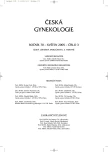-
Medical journals
- Career
Metastasing and Relapsing „Low Grade“ Adenosquamous Metaplastic Breast Cancer – is There a Really Indolent Lesion? A Description of Three Cases and Review of Literature
Authors: Z. Kinkor 1; A. Skálová 1; M. Michal 2; M. Janoušek 3; M. Kheck 4
Authors‘ workplace: Bioptická laboratoř s. r. o., Plzeň, vedoucí prof. MUDr. A. Skálová, CSc. 1; Šiklův ústav patologie, LF UK, Plzeň, vedoucí prof. MUDr. M. Michal, CSc. 2; Odd. patologie, Kladno, vedoucí prim. MUDr. M. Janoušek 3; Odd. patologie, Jihlava, vedoucí prim. MUDr. M. Kheck 4
Published in: Ceska Gynekol 2005; 70(3): 211-216
Category: Original Article
Overview
Objective:
To describe personnel experience with three unusual cases of low-grade adenosquamous carcinoma of the breast. Due to the aggressive course in two cases, the review of the literature does not concentrate on morphology and differential diagnosis only, but discuss overall biology of this lesion too.Design:
Three case reports.Setting:
Biopsy Lab s.r.o. and Šikl’s Department of Pathology, Charles University and Faculty Hospital, Pilsen.Methods:
Included are cases from mammary register of Biopsy Lab s.r.o. and from personnel consulting registry of Prof. Michal. In details are documented both clinical presentations, including follow up, and spectrum of histologic patterns of the lesion. Immunohistochemistry performed by streptavidin-biotin system (LSAB+, Dako) as detection system and diaminobenzidin tetrahydrochlorid as chromogen, employed standard myoepitelial markers (actin, CD10, calponin and p63), hormonal receptors, oncogen Her-2/neu, CK7, CAM5.2, CD34 and CD117.Results:
Partial mastectomy and segmentectomy were performed in three women 46, 72 and 74 years-old resp. for tumor, which size ranged from 20–35 mm in maximum diameter (mean 28 mm). Histology revealed low-grade adenosquamous metaplastic carcinoma displaying typical biphasic appearance combining regular tubular structures with surrounding storiform, sclerosing fibrous stroma. Variably present was characteristic squamous metaplasia of the gland forming either luminal morules or evident squamous pearls. Using immunohistochemistry, a total absence of myoepithelial layer in epithelial structures was confirmed. The stromal component expressed smooth muscle actin in two cases, one of which contained areas of heterologous chondrosseal differentiation. There were recognized metastases by one woman in two ipsilateral axillary lymph nodes mimicking benign breast heterotopia in one of them. One patient experienced recurrence in the scar 37 months after mastectomy where only mesenchymal heterologous component element was found. In two women with aggressive course the original biopsy was falsely interpreted, once as phyllodes tumor and secondly as benign sclerosing pseudotumor.Conclusion:
low-grade adenosquamous carcinoma, despite its bland histology, should be understood as regular malignancy prone to frequent recurrences and recognized metastatic potential. It arises in the deep breast tissue and structurally resembles the microcystic adnexal carcinoma of the skin. Low-grade adenosquamous carcinoma, however, has nothing to do with syringomatous adenoma of the nipple, which is a benign tumor of the skin adnexa. Differential diagnosis includes spectrum of non-neoplastic slerosing lesions and above-mentioned phylloid tumor. The rarity of this neoplasm does not exclude deep knowledge.Key words:
breast, low-grade, adenosquamous carcinoma, metaplastic carcinoma, radial scar
Labels
Paediatric gynaecology Gynaecology and obstetrics Reproduction medicine
Article was published inCzech Gynaecology

2005 Issue 3-
All articles in this issue
- Premature Separation of the Placenta – Etiology and Risk Factors
- Nalbuphine in Obstetrical Analgesia
- Changes of Coagulation Parameters during Stimulation in the IVF Programme and in Ovarian Hyperstimulation Syndrome
- Influence of Exogenous Supplementation with Luteinizing Hormone during Controlled Ovarian Hyperstimulation on the Results of IVF Cycle
- The Map of Superficial Lymphatic System of the Breast and Relation to the Sentinel Lymph Node
- On the Problem of Sentinel Lymphatic Nodes Examination in Mammary Cancer
- Histological Grade in Management of Carcinoma of Endometrium
- Reconstruction Procedures Following Pelvic Exenterations
- Metastasing and Relapsing „Low Grade“ Adenosquamous Metaplastic Breast Cancer – is There a Really Indolent Lesion? A Description of Three Cases and Review of Literature
- Immune, Inflammatory and Hormonal Changes in Connection with Laparoscopic Surgery
- Changes in Urethra Mobility after TVT Operation
- Laparoscopy in Chronic Pelvic Pain – a Prospective Clinical Study
- „Mixed“ and „Miscellaneous“ Vulvovaginitis: Diagnostics and Therapy of Vaginal Administration of Nystatin and Nifuratel
- Fistula as a Complication of Pelvic Actinomycosis – Two Case Reports
- Czech Gynaecology
- Journal archive
- Current issue
- Online only
- About the journal
Most read in this issue- Nalbuphine in Obstetrical Analgesia
- Premature Separation of the Placenta – Etiology and Risk Factors
- „Mixed“ and „Miscellaneous“ Vulvovaginitis: Diagnostics and Therapy of Vaginal Administration of Nystatin and Nifuratel
- Metastasing and Relapsing „Low Grade“ Adenosquamous Metaplastic Breast Cancer – is There a Really Indolent Lesion? A Description of Three Cases and Review of Literature
Login#ADS_BOTTOM_SCRIPTS#Forgotten passwordEnter the email address that you registered with. We will send you instructions on how to set a new password.
- Career

